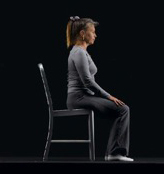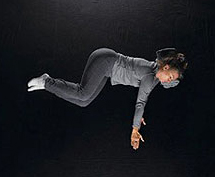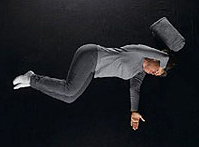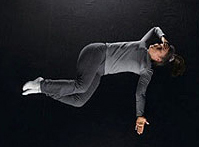Almost every day I hear the question, “What is good posture?” To me, this question reveals that posture is difficult to think about and difficult to feel. You may think about posture in the standard way: as the bones of your body being stacked up like bricks and your balance and mechanical alignment being ideally expressed with your head in a precise position above your chest, which is in a precise position above your pelvis, and so on, down to your feet on the floor.
But actually, good posture is being able to adapt our posture to many situations and to use it to express who we are socially. So perhaps a better question than “What is good posture?”— as if posture were a static sort of thing — would be: “What is the range of postural possibilities?” How adaptable is your posture to different situations? If your posture creates pain, then you need to move differently inside of yourself and not stand like a stack of bricks.
Here are a couple Change Your Age tips on how to transform your postural habits and a sample lesson from the book Change Your Age.
How to Transform Your Habits
 TIP #1: Sit in the middle of a chair with your feet directly under your knees. Push down through your legs only enough to bounce your pelvis forward, toward the front of the chair, and then backward a little farther, toward the back of the chair.
TIP #1: Sit in the middle of a chair with your feet directly under your knees. Push down through your legs only enough to bounce your pelvis forward, toward the front of the chair, and then backward a little farther, toward the back of the chair.
With your hands on your belly, tilt backward in the chair a little bit until you feel the muscles in your stomach contract. Tilt forward and backward a few times and feel how your stomach muscles engage in support of the belly.
Put your hands on your waist or your stomach to feel how those muscles work as you bounce your pelvis forward and backward.
TIP #2: While standing, can you reach one arm up toward the ceiling or the sky? Look at your hand and keep reaching until you feel your outstretched arm lifting your ribs. Make sure your jaw stays open. Put your arm down and do the same with the other arm. Let the reach occur as if someone were pulling you up higher through that arm. Your heels might come off the floor. Then simply stand and notice how much taller you feel. As you walk, you can always be prepared to reach up and point to the sky.
Postural Habits- Sample Lesson
This lesson asks you to be intuitive and instinctual and to trust yourself. Unlike other fitness books, you won’t find strict rules on repetitions or time limits here; I’ll suggest parameters, but the Change Your Age program is about being in touch with your body and brain—and your sense of movement.
Before you start this lesson, read through it and look to the photos for guidance. This mental rehearsal will help you unleash your physical imagination.
- GO SLOWLY—Take your time, you’ll learn more!
- INSIST ON COMFORT—If it hurts, it’s not helping you. Never try to override pain if you feel it.
- USE YOUR IMAGINATION—Allow the movement to become very clear and lucid in your mind, like a scene from a movie.
- REST FREQUENTLY—These movements, while gentle and pleasurable, may cause slight strain because you are using parts of muscles you may not have used in a long time, or you may be using them in ways that are not familiar.
- CHOOSE A COMFORTABLE SPACE—Make sure that you have space around you to move and that your clothes are loose enough to not restrain your movement.
Lesson 8: The Middle of the Body: Expanding, Reaching, and Turning
Intention: To decrease stress and tightness while increasing the ease of motion in your waist. Stress commonly causes a person to tighten in the middle of the body. This reflex tightness is meant only as a temporary protection during a crisis, but it can become a habit. In this de-aging lesson, you will explore how the movement of the arm or the head requires participation throughout the body if strain is to be avoided. Reaching more easily involves understanding the connection of the arms to the torso and pelvis.
Starting Position: Lie on your left side with your hips and knees bent at right angles and your arms straight out in front of you at chest level. See that the palms and fingers of your hands are resting together and make sure that your elbows are straight.
Change Your Age Tip: If your neck is strained when you lie on your side, put a folded towel under your head so that your neck is supported. If it does not seem possible for both elbows to rest straight, you might need to adjust your side-lying position. If you are rolled slightly forward, your top elbow will be bent. If you are rolled backward, your fingertips won’t line up.
 1. Slowly slide your right palm along your left palm, reaching for the floor in front of you then slide the left palm over your right hand and forearm. Repeat this motion several times, sliding your right palm forward, then back along your left forearm and upper arm. Feel the texture of your arm and the floor. You will notice that your range of motion expands naturally as you repeat the movement. Think about where the ability to reach farther comes from. Does your back assist? Does your pelvis move?
1. Slowly slide your right palm along your left palm, reaching for the floor in front of you then slide the left palm over your right hand and forearm. Repeat this motion several times, sliding your right palm forward, then back along your left forearm and upper arm. Feel the texture of your arm and the floor. You will notice that your range of motion expands naturally as you repeat the movement. Think about where the ability to reach farther comes from. Does your back assist? Does your pelvis move?
2. The next time you slide your right palm along your left palm and left forearm, continue to slide it all the way across your chest. Make sure you are performing long, lazy movements. Make sure your hand is always touching some part of your body softly and fully. Do not move any farther than you are able to go while still breathing comfortably. You will find it’s not worth it to compromise easy, natural breathing. Repeat this movement several times, then rest long and comfortably on your back.
 3. This time roll onto your left side in the same position, knees and feet touching, and bring your right hand to cover your forehead, with your elbow pointing straight in the air. Roll your head slowly toward the floor and back, feeling your elbow move through space until you are facing the ceiling. What happens to your waist? What happens in your ribs? The next time you roll, see whether you can gently bring your elbow all the way toward the floor in front of you. When you roll your head to face the ceiling, can you bring your right elbow all the way toward the floor behind you? Feel the opening in your chest and the movement in your waist. Don’t strain to do this motion. Instead, move more slowly and carefully each time. Take a full rest on your side with your elbows and palms together.
3. This time roll onto your left side in the same position, knees and feet touching, and bring your right hand to cover your forehead, with your elbow pointing straight in the air. Roll your head slowly toward the floor and back, feeling your elbow move through space until you are facing the ceiling. What happens to your waist? What happens in your ribs? The next time you roll, see whether you can gently bring your elbow all the way toward the floor in front of you. When you roll your head to face the ceiling, can you bring your right elbow all the way toward the floor behind you? Feel the opening in your chest and the movement in your waist. Don’t strain to do this motion. Instead, move more slowly and carefully each time. Take a full rest on your side with your elbows and palms together.
4. Glide your right palm slowly against your left palm, moving it forward and then bringing it back toward your chest. Can you bring your right arm all the way across your chest? Can you bring it to your right shoulder? Can you bring it back behind you so that the back of your right hand is resting on the floor? To do this, allow your knees to separate if they want to, and feel the movement of your pelvis against the floor. Repeat this movement several times. Take a full rest on your back.

5. Roll onto your right side with your hips and knees at right angles, your arms level with your chest and bent at the elbows, and your palms and fingertips together. Slide your left palm slowly along the right one onto the floor, then bring it back along your right forearm and upper arm. Can you bring your left arm across your chest? Is it easier on this side? Can you bring your left arm behind you so the back of your left hand rests on the floor? Rest briefly on your right side with your fingertips touching.
6. Bring your left hand to your forehead with your palm flat against your forehead and your elbow pointing straight in the air. Roll your head a little bit forward, toward the floor, then back toward the ceiling. Feel the direction of your elbow in the air. Can you sense the inside of your mouth? The back of your right knee? Roll your head gently forward and rest on your side with your left palm against your forehead and your left elbow touching the floor.
7. Roll onto your left side and arrange yourself with your hips and knees at right angles and your arms level with your chest and bent at the elbows. This time, clasp your hands together with your fingers interlocked. Gently slide your right knee forward and backward over your left knee, keeping your ankles and feet together. Don’t lift the right knee off the left knee; simply slide it forward then backward. Let your pelvis and waistline turn while you keep your elbows straight. Can you feel your pelvis clearly rolling? Rest on your side with your palms flat against each other.
8. Now slide your right hand against your left hand toward the floor while sliding your right knee backward. Then do the opposite. As you bring your right hand back, roll your right knee forward.
Repeat this motion several times until it becomes easier to do this opposition of arm and leg. Make sure you can breathe comfortably. Give yourself time to learn. Rest long and comfortably on your back.
9. Roll onto your right side with your elbows straight in front of you, hands interlocked. Slide your left knee forward and backward against your right knee, using your pelvis and back to help.
In your own time, repeat these opposing movements of arms and legs. Do not strain—let it happen gently, in its own time.
Take a long, full rest on your back and observe your comfort on the floor. You may discover that you have lost several years of stressed muscles.
For more movement lessons, tips and helpful routines, buy the Change Your Age book and the Change Your Age video program.
